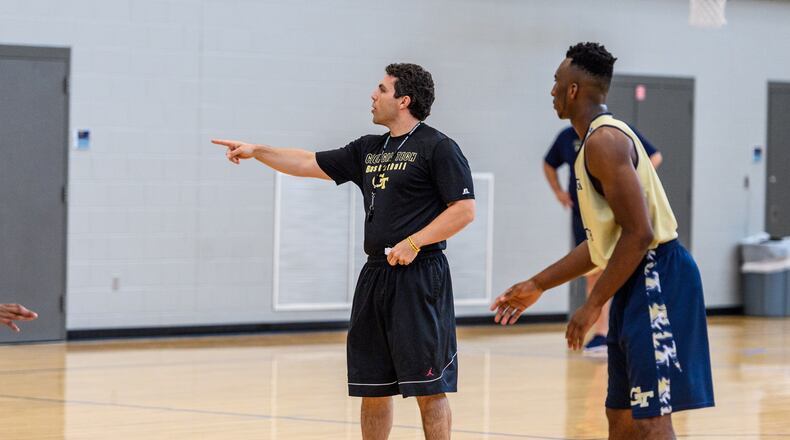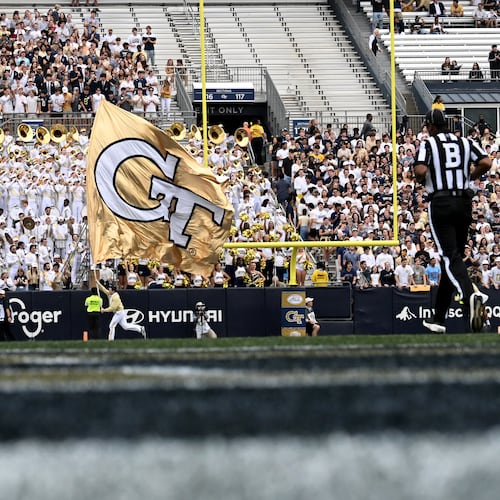Georgia Tech coach Josh Pastner was a popular figure on the AAU circuit this summer, and not only because colleagues wanted to congratulate him on the Yellow Jackets’ success in his first season. It’s Tech’s expiring apparel deal with Russell Athletic. The contract expires in June 2018.
“A lot of people have asked about it,” Pastner said.
The inquiries have come more from coaches than prospects, he said, both AAU and college. Pastner has punted the question, saying the next apparel provider for the Yellow Jackets will be decided by athletic Todd Stansbury and that “whatever he wants, I’m two feet in with.”
In his podcast last week, Stansbury said that he hoped to make an announcement about Tech’s next apparel provider “in the not-too-distant future.”
Pastner was a little more willing to shed light on the role he thinks shoes and gear plays in influencing prospects in their recruitment. In short, he believes it does.
“Uniform look and the amount of shoes you get or what type of shoe you’re wearing, all that stuff matters when you’re dealing with a 17-year-old guy,” Pastner said.
Chris Williams coaches Game Elite, a Georgia-based team of rising juniors, many of whom have received offers from Tech.
Leaving Russell “will definitely help them get higher-tier kids, like five-star kids, in there,” he said. “At the end of the day, kids still look at what they’ve got to wear, regardless.”
Judging from responses from prospects interviewed at the recent AAU tournaments in Las Vegas, either coaches are overselling the influence or the kids are downplaying it.
Of six players queried who have been offered scholarships by Georgia Tech, only one acknowledged that sneakers will make a difference, Christian Brown, a highly-rated junior forward from Columbia, S.C., who plays for Game Elite. The other five said it would not. Nasir Little, a senior forward from Orange Park, Fla., and a high priority for Pastner, allowed that Tech leaving Russell Athletic is a plus, but whether Tech aligns with Adidas, Nike or Under Armour won’t make a difference.
“It’s all about basketball, who’s going to help me get to the next level,” said Will Richardson, a senior point guard from Liberty County. “I’m not really worried about anything else.”
A look at ESPN’s top 50 prospects from the 2016 class doesn’t offer conclusive indication of brand loyalty, although it may reflect Nike’s dominance of the market. Of the 46 players whose AAU teams’ sneaker alliances were readily determinable through an online search, 27 played for Nike travel teams, 13 played for Adidas teams and six competed for teams sponsored by Under Armour. Of the 46, 28 chose schools that had the same partner as their AAU teams, about 61 percent.
However, attributing that rate to loyalty might be misguided. Take Nike, for instance.
Of the 27 players who were with Nike-sponsored AAU teams, 20 chose colleges that also wear Nike gear. However, nine of those 20 chose Duke, Kentucky, North Carolina or Michigan State. It would seem a stretch to contend that sneaker affiliation was a driver in the decision to play for perennial contenders for the national championship.
Also, of the 19 players who were with Adidas or Under Armour schools – underdogs where it might seem more influence would be brought to bear to stay in the family – only two stayed with their AAU brand for their college choice. Again, some context is necessary. The only Under Armour school that might have been considered a basketball powerhouse at the time that recruits in the 2016 class made their college decisions was Notre Dame.
Nike, though, would appear to be the big winner. Of the 46, 34 of the prospects chose Nike schools, followed by Adidas with 10 and Under Armour with two. Besides being most popular among prospects with Nike AAU teams, it was the same for prospects with Adidas and Under Armour teams. Out of 19 players from Adidas and Under Armour teams, 14 signed with Nike schools.
That statistic deserves a considerable caveat, however. Of the 65 power-conference schools, 44 of them will wear Nike in 2017-18. Again, how much prospects were choosing Nike vs. how much they were choosing a school that happened to wear that brand is not easily discerned.
What is there to learn? Perhaps that, at the least, being with Nike doesn’t hurt.
About the Author
Keep Reading
The Latest
Featured




